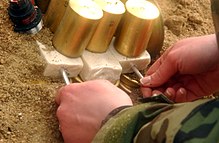Plastic explosive

Plastic explosive is a soft and hand-moldable solid form of explosive material. Within the field of explosives engineering, plastic explosives are also known as putty explosives.[1]
Plastic explosives are especially suited for explosive demolition. Common plastic explosives include Semtex and C-4. The first discovered plastic explosive was gelignite in 1875, invented by Alfred Nobel.
Usage

Plastic explosives are especially suited for explosive demolition of obstacles and fortifications by engineers, combat engineers and criminals as they can be easily formed into the best shapes for cutting structural members and have a high enough velocity of detonation and density for metal cutting work.
An early use of plastic explosives was in the warhead of the British Armoured Vehicle Royal Engineers's (AVRE)'s Petard demolition mortar, used to destroy concrete fortifications encountered during Operation Overlord (D-Day). The original use of Nobel 808 supplied by the SOE was for sabotage of German installations and railways in Occupied Europe.[citation needed]
They are generally not used for ordinary blasting as they tend to be significantly more expensive than other materials that perform just as well in this application.[dubious ] A common commercial use of plastic explosives is for shock hardening high manganese percentage steel,[2] a material typically used for train rail components and earth digging implements.
Some terrorist groups have used plastic explosives. In October 2000, al-Qa'ida used C-4 to attack the USS Cole, killing 17 sailors[3] In 1996, terrorists used C-4 to blow up the Khobar Towers U.S. military housing complex in Saudi Arabia.[4]
Reactive armor in tanks uses plastic explosives sandwiched between two plates of steel. Incoming high explosive anti-tank rounds pierce the outer steel plate, then detonate the plastic explosive. This absorbs the energy from the incoming tank round and shields the tank.[5]: 9
History

The first plastic explosive was gelignite, invented by Alfred Nobel in 1875.[6] Prior to World War I, the British explosives chemist Oswald Silberrad obtained British and U.S. patents for a series of plastic explosives called "Nitrols", composed of nitrated aromatics, collodion, and oxidising inorganic salts.[7] The language of the patents indicate that at this time, Silberrad saw no need to explain to "those versed in the art" either what he meant by plasticity nor why it may be advantageous, as he only explains why his plastic explosive is superior to others of that type.[citation needed]
One of the simplest plastic explosives was Nobel's Explosive No. 808, also known as Nobel 808 (often just called Explosive 808 in the British Armed Forces during the Second World War), developed by the British company Nobel Chemicals Ltd well before World War II. It had the appearance of green plasticine with a distinctive smell of almonds. During World War II it was extensively used by the British Special Operations Executive (SOE) for sabotage missions. It is also the explosive used in HESH anti-tank shells and was an essential factor in the devising of the Gammon grenade. Captured SOE-supplied Nobel 808 was the explosive used in the failed 20 July plot assassination attempt on Adolf Hitler in 1944.[citation needed]
During and after World War II a number of new RDX-based explosives were developed, including Compositions C, C2, and eventually C3. Together with RDX these incorporate various plasticisers to decrease sensitivity and make the composition plastic. The origin of the obsolete term "plastique" dates back to the Nobel 808 explosive introduced to the U.S. by the British in 1940. The samples of explosive brought to the U.S. by the Tizard Mission had already been packaged by the SOE ready for dropping via parachute container to the French Resistance and were therefore labelled in French, as Explosif Plastique. It is still referred to by this name in France and also by some Americans.
Types
Composition C


The British used a plastic explosive during World War II as a demolition charge. The specific explosive, Composition C, was 88.3% RDX and 11.7% non-oily, non-explosive plasticizer. The material was plastic between 0 and 40 degrees C, but was brittle at colder temperatures and gummy at higher temperatures. Composition C was superseded by Composition C2, which used a mixture of 80% RDX and 20% plasticizer. Composition C2 had a wider temperature range at which it remained plastic, from -30 to 52 degrees C. Composition C2 was replaced by Composition C3, which was a mixture of 77% RDX and 23% explosive plasticizer.[8]: 8–109 C3 was effective but proved to be too brittle in cold weather and was replaced with C4. There are three classes of C4, with varying amounts of RDX and polyisobutylene.[8]: 8–111
List of plastic explosives

- Austria: KAUERIT
- Czech Republic: Semtex-H (orange colored), Semtex 1A (red colored), NP10 (black colored)
- Finland: PENO
- France: PE4, PLASTRITE (FORMEX P 1)
- Germany: Sprengkörper DM12, (Sprengmasse, formbar)
- Netherlands: Knaverit S1 (light orange colored)
- Greece: C3, C4
- Israel: Semtex
- Italy: T-4 Plastico
- Norway: NM91(HMX), C4
- Poland: PMW, NITROLIT
- Russia: PVV-5A Plastic Explosive
- Slovakia: CHEMEX (C4), TVAREX 4A, Danubit
- Sweden: Sprängdeg m/46
- Switzerland: PLASTITE produced by SSE
- USA: C-4 (Pure White)(Composition C-4)
- United Kingdom: PE7 (off-white colored),[9] DEMEX (sheet explosive)
- Yugoslavia/Serbia: PP–01 (C4)
See also
References
- ^ Cooper, Paul W. (1996). "Chapter 4: Use forms of explosives". Explosives Engineering. Wiley-VCH. pp. 51–66. ISBN 0-471-18636-8.
- ^ Explosive Hardening, PA&E, Inc.
- ^ Whitaker, Brian (21 August 2003). "Bomb type and tactics point to al-Qaida". The Guardian. London: Guardian Media Group. Retrieved July 11, 2009.
- ^ "ATTORNEY GENERAL STATEMENT ON KHOBAR TOWERS INDICTMENT". fas.org.
- ^ Ledgard, Jared (2007). "Introduction to Explosives". A Soldiers Handbook, Volume 1: Explosives Operations.
- ^ Braddock, Kevin (3 February 2011). "How to handle gelignite". Wired Magazine. Retrieved 25 February 2012.
- ^ US Patent # 1092758
- ^ a b Military Explosives. 1989.
- ^ http://www.eurenco.com/content/explosives/demolition-breaching/new-generation/explosive-blocks/f. Retrieved March 18, 2014.
{{cite web}}: Missing or empty|title=(help)[dead link]
